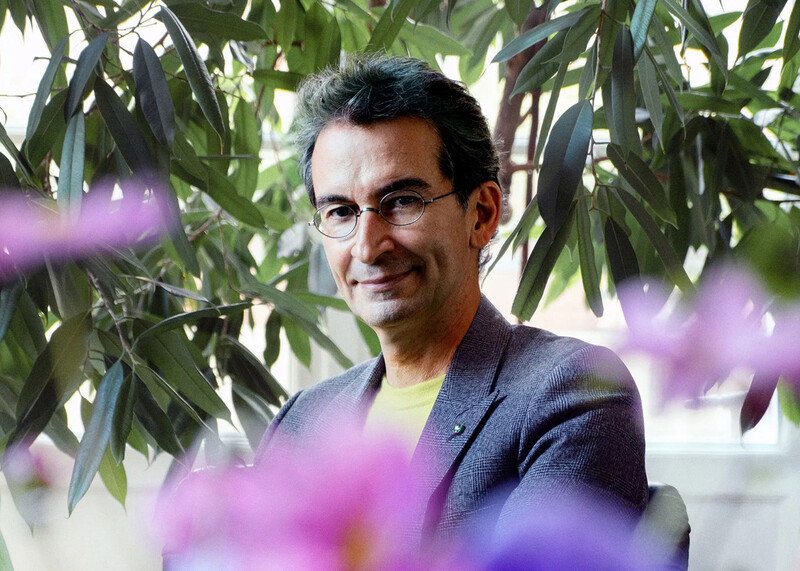With a blast of its horn, the ferry departs from the Battery Maritime Building on South Street and churns into the East River. It’s a balmy Friday morning in mid-October, and the decks of the boat are packed with bicyclists, raucous high schoolers, tourists with cameras and clip-on cell phones, sketch artists, daydreamers, young lovers, history buffs, and couples with and without small children. People on deck watch eagerly as the destination comes closer: a loaf of land at the confluence of the Hudson and East rivers, a small island marked by fluffs of trees, stately brick buildings, and, at the water’s edge, what appears to be an ancient, rounded fortress or coliseum.
Minutes later, the ferry docks beside a sandy, man-made beach with a volleyball net and plastic palm trees bearing coconuts of red, yellow, and blue. Straight ahead, and higher up, beyond the emerald green turf and stone-wall tiers of Fort Jay, is the mast of a lone flagpole, rising from the island’s star-shaped heart. For over 200 years, this locale served as a military post for the Army and, more recently, the Coast Guard, which left in 1996. In 2003, the U.S. government sold most of the island’s 172 acres to New York State. Now it belongs to everyone.
The crowd disembarks. On the gangplank, one of the passengers, Ann Buttenwieser ’84GSAPP, observes the scene with satisfaction. This is what it’s all about: New Yorkers taking a free ferry ride to enjoy their waterfront, descending, on this final weekend of the season, upon the cannon-studded, mansion-dotted, elm tree–shaded, water-bound pastures of Governors Island.
Buttenwieser’s career — as a waterfront planner, urban historian, parks advocate, and writer — reaches its apotheosis here. Her new coffee-table book, Governors Island: The Jewel of New York Harbor, fittingly monumental in size and scholarship, covers three centuries of military history, while her work on the board of the Governors Island Preservation and Education Corporation, which operates 150 acres (the rest is run by the National Park Service as the Governors Island National Monument), looks to the island’s future as a public space.
Ashore, Buttenwieser, who is an adjunct associate professor of urban planning at Columbia, strides along a paved walkway leading to some of the treasures of this abandoned installation. She is petite and brisk, with blond hair and wide, clear eyes that might best be described as swimming-pool blue. She speaks in a soft but authoritative voice that brings a listener’s ear closer. “That’s Castle Williams,” she says, nodding at the rounded sandstone fortress. “It was completed in 1811, for the war with the British. During the Civil War, it served as a prison for Confederate soldiers.” New York’s very own Alcatraz.
Buttenwieser continues on the path, turning onto Colonels’ Row, a two-acre green shaded by trees and lined with handsome brick buildings and columned houses. There are officers’ quarters, an empty hospital (the birthplace, notes Buttenwieser, of Tom and Dick Smothers), and a startlingly long barracks in the neo-Georgian style.
“Liggett Hall was the longest military barracks in the world,” says Buttenwieser, pointing with her chin. “It’s longer than the height of the Chrysler Building.”
“Longest in the world?” says one of her companions, since Governors Island seems too small to have the longest anything.
“In the world,” Buttenwieser repeats, with a slight emphasis that settles the question for all time.
“Motherhood.” That’s the answer Ann Buttenwieser gives when asked about the origins of her park advocacy. In the early 1960s, as the mother of four young children, Buttenwieser spent many hours in the playgrounds of Central Park. There, she noticed that kids were getting hurt when they fell from the swings onto the asphalt surface. So she organized a group of parents in hopes of getting some help from City Hall. The group confirmed the asphalt problem by speaking with pediatricians at Lenox Hill Hospital, and located a company that produced a rubber matting called Safety Surf. When the city still wouldn’t pay for the resurfacing, Buttenwieser and friends raised $50,000 for a two-playground trial. “We brought the proposal and the money to the Parks Department, which was headed by Newbold Morris,” she says. “It took two years, but we got the city to do it.” Playground injuries dropped. Within five years, Safety Surf was in the parks budget, and remains so today.
The success led Buttenwieser into more ambitious territory. In the late 1960s, she cofounded, with future parks commissioner Henry J. Stern, the Council for Parks and Playgrounds, a citywide park advocacy organization that later became New Yorkers for Parks. (Buttenwieser is still on the board.) But, like Melville’s seagazing crowds “pacing straight for the water,” Buttenwieser was inevitably drawn back to her element.
While working on her dissertation in the early 1980s (a landmark urban history called Manhattan Water-Bound: Manhattan’s Waterfront from the Seventeenth Century to the Present), Buttenwieser received a call from Albany. Governor Hugh Carey wanted to appoint her to a commission charged with deciding what would happen on the 90 acres of waterfront parkland intended for Westway, the $2.2 billion, 220-acres-of-landfill public works project that was poised to turn the crumbling West Side Highway into a six-lane supertunnel. Buttenwieser accepted the post, assuming (along with everyone else) that the plan, which had support in high places, was a done deal. But Westway became a death battle, pitting the bullhorns and slingshots and pesky lawsuits of neighborhood activists against the big guns of labor, business, and government. Opponents feared that the property above the tunnel — and the parkland, too, eventually — would be turned mostly into luxury housing.
In August 1985, a year before the U.S. Fish and Wildlife Service petitioned for the northern spotted owl in Oregon to be listed as “threatened” over the objections of the timber industry, a federal judge in the Westway case ruled that the government had provided flawed testimony about the project’s impact on the spawning habits of the Hudson’s striped bass. With that, Westway’s defeat was sealed.
“There was a tremendous amount of antagonism toward the proposal,” Buttenwieser says. “The people who opposed it latched onto the environmental issue. At that time, and for many years afterward, environmental issues were used to stop projects. Nowadays, that seems to be less the case.”
After earning her doctorate in urban planning in 1984, Buttenwieser went to work for the Department of City Planning, Waterfront Division, where she “traveled the country to see what other cities were doing, to try to find some models for New York.” Six months into the job, she was “yanked away,” this time by Governor Mario Cuomo and Mayor Ed Koch. When Westway fell, Koch and Cuomo set up the New York State–New York City West Side Task Force to figure out what to do with the roadway and the piers. And they wanted Buttenwieser to be deputy director.
The task force set to work, and 25 years later we see the results: a six-lane, mostly at-grade boulevard (Joe DiMaggio Highway, officially) and the five-mile-long Hudson River Park, with its bikeways and walkways, luxuriant green lawns, landscaped piers, extensive recreation facilities, large seasonal crowds — and, in the water — plenty of striped bass.
Like the prolific park builder Robert Moses ’14GSAS, Ann Buttenwieser is a swimmer. She was born in Annapolis in 1935, and grew up on the Chesapeake Bay. Her father, Isador Lubin, was an economic adviser to President Franklin D. Roosevelt. When Ann was 11, Lubin took a job as industrial commissioner under Governor W. Averell Harriman ’54HON of New York. The family moved to Manhattan, which had a different waterfront from the one Ann was used to. “It was an industrial waterfront,” she says. “There was shipping and transportation. In high school, I went to France on the Ile de France, which left from the West Side piers, and I arrived home after my year abroad on the S.S. America, which also landed on the West Side. And to get to Annapolis you had to take the B&O [Baltimore & Ohio] Railroad — you got on a float car on the West Side and a barge took you across the river, where the B&O started. That’s what the waterfront was.”
After graduating from the Dalton School, Ann attended Swarthmore, where she studied literature, competed on the swim team (she was a diver, too), and, at a Federation of Jewish Philanthropies benefit, met Larry Buttenwieser, a law student whose father, Benjamin Buttenwieser ’19CC, ’64HON, was a prominent banker, philanthropist, and Columbia trustee. (Larry’s mother was the former Helen Lehman, of the Lehman banking and political family.) Ann Lubin Buttenwieser transferred to Barnard for her senior year, had her first child, and, after graduating, settled into parenthood on the Upper East Side.
Then came the asphalt playgrounds, the Safety Surf, and a taste for the good fight, for getting things done. What else could she achieve, given her talents and connections and expanding civic consciousness? How else to improve the lives of the children of New York?
A compelling answer presented itself while Buttenwieser was researching Manhattan Water-Bound in 1980. In a dusty room under the Battery Maritime Building, she discovered files from the Department of Ports and Terminals, dating from 1872 to 1935. They contained repeated references to “floating baths.”
These baths, Buttenwieser learned, were actually seagoing public swimming pools that had been built for the city’s tenement poor, with slatted bottoms that allowed the pools to fill with river water. Inspired, Buttenwieser wrote an op-ed and sent it to the New York Times, proposing the idea be revisited (with clean water, of course), given the lack of public pools citywide. “I thought, ‘Let’s bring them back,’” she recalls. The Times ran the piece on Memorial Day 1980, and for the next 20 years, at community and waterfront meetings, Buttenwieser talked about the floating pools. And talked. Mayor Koch offered her a garbage barge that would cost $1 million to rejigger, but before she raised a single dollar, the boat sank. And so in 2000, Buttenwieser took matters into her own hands.
What followed was a textbook-worthy case of a Big Idea — ambitious, expensive, and improbable — making headway in rough seas (literally: the barge that was eventually purchased was being renovated in New Orleans at the time of Hurricane Katrina, causing a five-month delay), until finally, majestically, it enters port.
In her class at Columbia, called “Architecture, Planning, and Preservation: New York,” Buttenwieser uses the story to illustrate how things work. First, to solicit funds, you must establish a not-for-profit (the Neptune Foundation); then you have to raise the money, make yourself an expert in an esoteric subject (decommissioned river barges), hire an architect, obtain permits, confront frightful cost overruns, and generally swim in an ocean of red tape.
Worth it? Buttenwieser’s voice tightens as she describes seeing the barge, christened The Floating Pool Lady, her gift to the city, arriving in New York harbor in the autumn of 2006. “It was,” she says, “like it was coming home.”
The seven-lane public pool, which berthed at Brooklyn Heights in the summer of 2007, drew more than 50,000 people that year. Next summer it will begin its third season docked off Barretto Point Park, in the Hunts Point section of the Bronx.
But if reading about the floating baths gave Buttenwieser her big idea, it’s tempting to imagine that the general concept was wafting in her consciousness for some time.
In an August 1965 issue of Life magazine, in the “Ideas in Houses” section, there is a photo essay called “A Fortress by the Sea.” The piece highlights an imposing structure built on a spine of rock on Long Island Sound. Designed by the architect Ulrich Franzen for the Buttenwieser family, the house has three three-story brick towers and sits right on the sapphire-colored water.
The first photo shows a rectangular swimming pool lying at the foot of one of the towers. Above the pool’s far edge is a protective railing. Beyond the railing, the crystal blue bay. It appears, from that angle, that the pool is floating on the sea.
Governors Island: The Jewel of New York Harbor is itself a formidable piece of architecture, and Buttenwieser took special pleasure in its design and construction. In seven big, eventful chapters illustrated with photographs, maps, and drawings, Buttenwieser revives a potent little world, exposed on all sides to the winds of war, peace, and politics.
One of the book’s heroes is Elihu Root, “a highly regarded New York City attorney who was well connected socially and politically.” Root, who would later become secretary of state under Theodore Roosevelt and win the 1912 Nobel Peace Prize, was appointed secretary of war by President William McKinley in 1899, and became the master builder of Governors Island. He oversaw the island’s expansion and beautification, handpicked the architectural firm (McKim, Mead & White, which had recently drawn up the master plan for Columbia’s Morningside Heights campus), and exercised his “political savvy and his uncanny ability to implement an agenda for Governors Island,” as Buttenwieser writes. “Probably only George Washington, who had ordered construction for the first fort, had exerted the same impact.”
There’s a cyclical wonder to it. A pre–Revolutionary War military installation, boldly expanded, beginning in 1903, to more than twice its size (using landfill from the new Lexington Avenue subway line) by an unyielding administrator, becomes, 100 years later, a giant playground. Picnickers and cricketers share the rolling green of Fort Jay, visitors press their noses against the windows of the yellow Victorian mansions of Nolan Park, bicyclists and walkers traverse the three-mile esplanade, with water surging all around. There’s the Brooklyn Navy Yard, yonder across Buttermilk Channel, and Staten Island to the south, and, closer, looking as if she’s standing on the roof of a passing orange ferry, the Statue of Liberty. Waves lap the seawall, sending light spray upon the faces of watergazers seated on the movable benches, while behind them, readers lounge peaceably in hammocks, unwinding with the length of day.
Governors Island feels like a small miracle, an alternate reality in which the island was not, as almost happened between the two world wars, turned into a municipal airfield, or, as suggested by a revenue study commissioned by Mayor Rudolph Giuliani’s office in the 1990s, made home to a gambling casino.
In the end, the public stretches of New York’s 578 miles of waterfront will have been won by advocates who know how to work the system. And if it takes, say, a Moses-like power broker to do it, Buttenwieser isn’t complaining.
“No,” she says, with a twinkle of humor. “I think we need a czar.”



